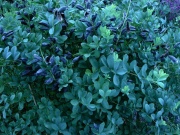Difference between revisions of "False indigo"
Jump to navigation
Jump to search
| (One intermediate revision by one other user not shown) | |||
| Line 6: | Line 6: | ||
== Synonyms and Related Terms == | == Synonyms and Related Terms == | ||
| − | wild indigo; indigo weed; Baptisia tinctoria | + | wild indigo; indigo weed; ''Baptisia tinctoria'' |
| − | == | + | ==Resources and Citations== |
* John and Margaret Cannon, ''Dye Plants and Dyeing'', Herbert Press, London, 1994 | * John and Margaret Cannon, ''Dye Plants and Dyeing'', Herbert Press, London, 1994 | ||
Latest revision as of 13:09, 24 July 2022
Description
A pale blue Dye produced from the leaves and blue flowers of Baptisia tinctoria plant. This perennial herb from the pea family is native to the southeastern United States. The leaves and flowers can be boiled in water to produce a blue dye that is rich in flavonoids including indican, pseudobatigenin, and orobol. It has been used as a substitute for Indigo.
Synonyms and Related Terms
wild indigo; indigo weed; Baptisia tinctoria
Resources and Citations
- John and Margaret Cannon, Dye Plants and Dyeing, Herbert Press, London, 1994
- The Merck Index, Martha Windholz (ed.), Merck Research Labs, Rahway NJ, 10th edition, 1983 Comment: entry 985
